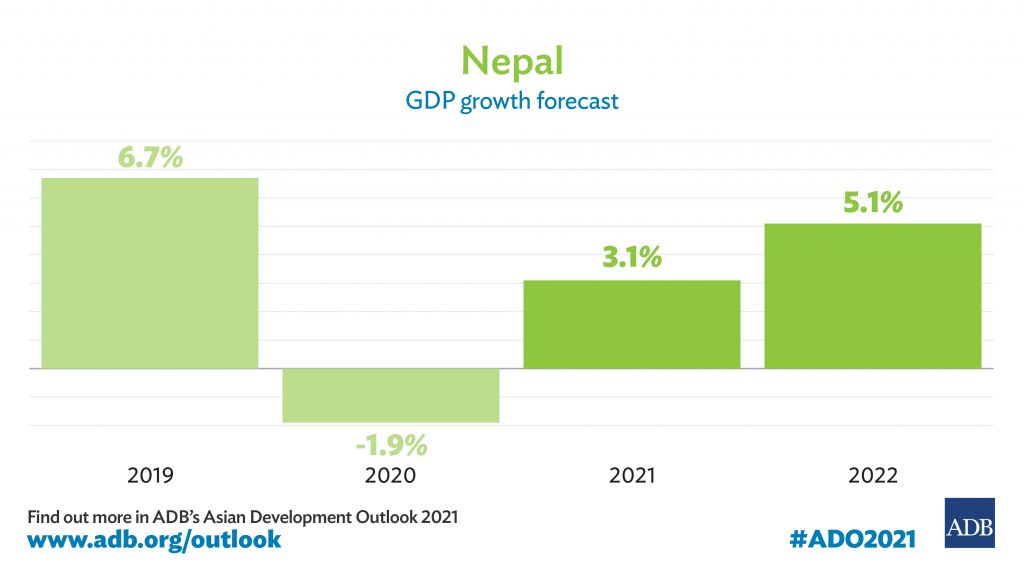Money
Nepal’s economy to post modest recovery this fiscal year, says Asian Development Bank
Nepal’s economy is anticipated to grow by 3.1 percent this fiscal year 2020-2021 ending mid-July from a contraction of 1.9 percent in the last fiscal year. But there are downside risks to the outlook on a resurgence of Covid-19 infections.
Post Report
Nepal’s gross domestic product is anticipated to grow by 3.1 percent in fiscal year 2020-2021 ending mid-July from a contraction of 1.9 percent in the last fiscal year 2019-2020, according to the Asian Development Outlook unveiled on Wednesday.
The outlook, the flagship economic publication of the Asian Development Bank, has estimated that Nepal’s economic growth could recover from the low base in 2019-2020, as a result of the gradual lifting of nationwide lockdown since July 2020, and a pickup in domestic demand.
The ongoing vaccination campaigns against the coronavirus will help strengthen the economic impetus, it said.
But the growth estimate has not taken account of the government announced localized restrictions, which in Nepal’s financial hub Kathmandu, will begin from Thursday morning for at least two weeks.
Nepali authorities have been grappling to contain the rapid rise of Covid-19 cases as experts fear that tens of thousands of people may have caught the infectious mutant strains emerging out of Nepal’s immediate neighbour India.

“The Covid-19 contagion that seemed to have tapered off until end-March 2021 is now spreading rapidly. If strict containment measures that have been initiated to tackle this second wave of infections are necessary for a prolonged period in the remainder of this fiscal year, then economic growth will be lower than the forecast,” said Asian Development Bank officer-in-charge for Nepal Sharad Bhandari.
Agriculture is expected to rise by 2.4 percent this fiscal year as paddy yield is likely to increase by 1.3 percent, owing to a good monsoon and increased acreage under production. Manufacturing and service industries gradually reopened following the end of the lockdown in July 2020.
The affected industries, including micro, small, and medium-sized enterprises have been receiving economic support in the form of concessional lending and refinancing of existing loans to mitigate the adverse effects of the downturn.
Construction began to pick up, while the completion of some major projects of the government is expected to boost economic recovery. The Upper Tamakoshi Hydropower is expected to begin its first phase of production, while water from the Melamchi Water Supply Project began flowing in March.
Overall, the industry is expected to grow by 2.5 percent after contracting by 4.2 percent in the last fiscal year. The services sector is expected to grow by 3.4 percent this fiscal year, though hospitality, travel, and tourism sub sectors will take a longer time to recover, the multilateral funding agency said.
The outlook forecasts inflation to moderate to an average of 5.0 percent, down from 6.2 percent in the last fiscal year, on the back of a good harvest, smoother supply chains, and subdued non-food prices.
The current account deficit is expected to widen from 0.9 percent of GDP in 2019-2020 to 2.5 percent in 2020-2021, owing to increased import growth.
Nepal’s economic growth of 5.1 percent is envisaged for the next fiscal year 2021-2022 in anticipation of vaccination progress against Covid-19, regional and global economic recovery from this pandemic, assumption of a good monsoon leading to better harvest, and steady inflows of workers’ remittance.
Inflation is forecast to remain contained at an average of 6.0 percent in the next fiscal year, assuming a better harvest, subdued oil prices and modest uptick in inflation in India, the major trade partner of Nepal.
The main downside risk to the outlook centres on a resurgence of Covid-19 infections.
The outlook said that political uncertainties and policy inconsistencies, as well as recurrent natural calamities like floods and landslides, could also undermine growth prospects. A weaker than expected regional and global recovery would limit employment opportunities abroad for Nepali workers, constrain remittance and earnings from exports, and dampen Nepal’s growth.




 18.12°C Kathmandu
18.12°C Kathmandu














